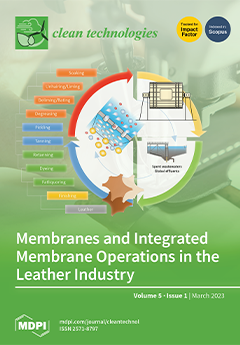Many technologies for the treatment of arsenic-containing drinking water are available, but most of them are more effective on arsenic oxidized forms. Therefore, the pre-oxidation of As
3+ is necessary. The electrochemical processes represent a very promising method due to the simultaneous oxidation of compounds using electrochemical conditions and the reactive radicals produced. In this work, As
3+ oxidation was experimentally studied at a pilot scale using an electrochemical oxidation cell (voltage: 10 V; current: 1.7 A). The effect of the initial arsenite concentration, pH, and conductivity of drinking water on the oxidation of As
3+ into As
5+ was investigated. The results showed that the initial As
3+ concentration strongly directly influences the oxidation process. Increasing the initial arsenite concentration from 500 to 5000 µg L
−1, the pseudo-first order kinetic constant (k) strongly decreased from 0.521 to 0.038 min
−1, and after 10 min, only 21.3% of As
3+ was oxidized (vs. 99.9% in the case of As
3+ equal to 500 µg L
−1). Slightly alkaline conditions (pH = 8) favored the electrochemical oxidation into As
5+, while the process was partially inhibited in the presence of a more alkaline or acidic pH. The increase in conductivity up to 2000 µS cm
−1 enhanced the kinetic of the oxidation, despite remaining on the same order of magnitude as in the case of conductivity equal to 700 µS cm
−1. After 10 min, 99.9 and 95% of As
3+ was oxidized, respectively. It is the opinion of the authors that the influence of other operational factors, such as voltage and current density, and the impact of the high concentration of other pollutants should be deeply studied in order to optimize the process, especially in the case of an application at full scale. However, these results provide helpful indications to future research having highlighted the influence of initial As
3+ concentration, pH, and conductivity on the electrochemical oxidation of arsenic.
Full article





